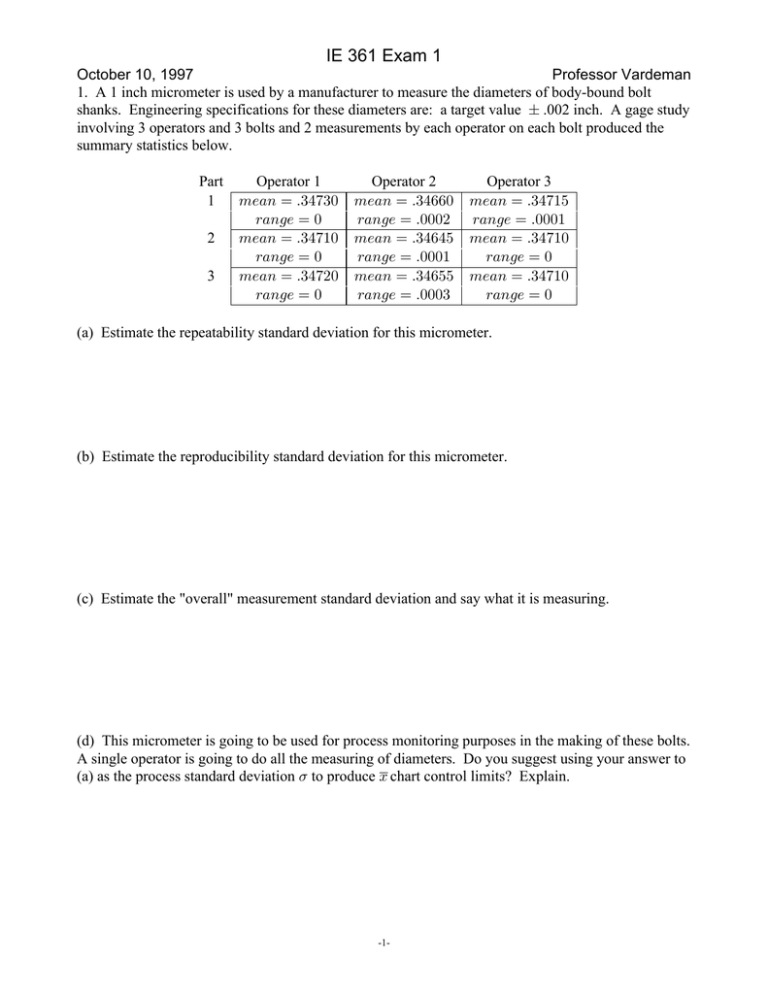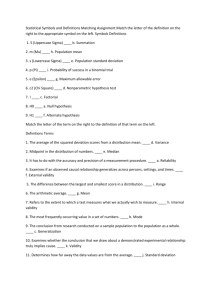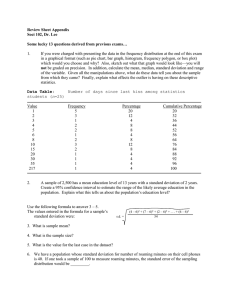IE 361 Exam 1
advertisement

IE 361 Exam 1 October 10, 1997 Professor Vardeman 1. A 1 inch micrometer is used by a manufacturer to measure the diameters of body-bound bolt shanks. Engineering specifications for these diameters are: a target value „ .002 inch. A gage study involving 3 operators and 3 bolts and 2 measurements by each operator on each bolt produced the summary statistics below. Part 1 2 3 Operator 1 7/+8 œ Þ$%($! <+81/ œ ! 7/+8 œ Þ$%("! <+81/ œ ! 7/+8 œ Þ$%(#! <+81/ œ ! Operator 2 7/+8 œ Þ$%''! <+81/ œ Þ!!!# 7/+8 œ Þ$%'%& <+81/ œ Þ!!!" 7/+8 œ Þ$%'&& <+81/ œ Þ!!!$ Operator 3 7/+8 œ Þ$%("& <+81/ œ Þ!!!" 7/+8 œ Þ$%("! <+81/ œ ! 7/+8 œ Þ$%("! <+81/ œ ! (a) Estimate the repeatability standard deviation for this micrometer. (b) Estimate the reproducibility standard deviation for this micrometer. (c) Estimate the "overall" measurement standard deviation and say what it is measuring. (d) This micrometer is going to be used for process monitoring purposes in the making of these bolts. A single operator is going to do all the measuring of diameters. Do you suggest using your answer to (a) as the process standard deviation 5 to produce B chart control limits? Explain. -1- 2. Consider a mean nonconformities per unit process monitoring problem, where the standard value of - is 1.0 nonconformities per unit. 5 œ "! units will be inspected at each period. (a) Show how to find the ARL for the "usual" monitoring scheme here if in fact - is twice its standard value. You don't have to produce a numerical value, but you must give me complete instructions on how to find one. (b) What is the probability that a particular single unit has at least one nonconformity if in fact - œ "Þ!? (c) A possible alternative means of process monitoring (alternative to the "usual" scheme referred to in part (a)) is to base a Shewhart chart on \ œ the number (out of 10) of units inspected that have at least one nonconformity . What are 3 sigma control limits for this quantity? (Hint: Use your answer to part (b)) 3. If it is to be practically effective, what must an engineering application of control charting involve beyond the simple naming of "out of control" points? -2- 4. Below are 20 sample means and ranges of thicknesses in samples of 8 œ & silicon wafers produced in the manufacture of integrated circuits. (Units are µm.) sample 1 2 3 4 5 6 7 8 9 10 B 246.8 244.6 245.0 242.6 244.6 244.0 244.4 248.0 243.4 245.0 V 13 13 11 14 9 8 9 5 10 9 sample B V 11 245.4 10 12 244.2 6 13 249.2 10 14 242.4 10 15 244.8 6 16 242.0 10 17 246.2 9 18 247.2 9 19 247.4 8 20 246.4 6 It is possible to verify (don't bother to do so) that for these samples B œ #%&Þ") and V œ *Þ#&. (a) Find retrospective control limits for the ranges. Apply them to the ranges in the table and say what is indicated about the physical stability of the wafer-grinding process. (b) Estimate the process short term standard deviation based on the 20 ranges. (c) Find retrospective control limits for the means. Apply them to the means in the table and say what is indicated about the physical stability of the wafer-grinding process. (d) Based on your answer to (b) and the ideal process mean of 244 µm, give 3 sigma control limits for future monitoring of medians of samples of size 8 œ $. -3- (e) Suppose that in fact the measurement process used to produce the values in the table above has an associated "sigma" of 1.00 µm. Think of measured thicknesses, B, in the terms B œ > € /, where > is a "true" thickness and / is measurement error. Think of > and / as independent random variables. If the standard deviation of B is as you estimated it in (b) and the standard deviation of / is 1.0, what standard deviation ought to be associated with >? (Hint: Recall Stat 231. What is VarÐ\ € ] Ñ for independent \ and ] ?) (f) Your answer to (e) should be smaller than your answer to (b). Suppose that engineering specifications on these thicknesses are P œ #$* µm and Y œ #%* µm (so that the mid-specification is 244). If the process mean is assumed to be on-target at 244 µm and normal distributions are used, which "sigma" (the one from (e) or the one from(b)) would produce the largest estimated fraction of product inside specifications? the "sigma" producing the largest "fraction in specifications" is the one in part ________ To which of "B" or ">" in part (e) do you think that P and Y are meant to apply? Explain. (Vardeman doesn't know the answer to this, but wants to read your reasoned response.) 5. Miscellaneous Short Answers. (a) Explain why modern quality assurance is focused on "processes" rather than "products." (b) If specifications are P œ $ and Y œ ( and I tell you that all B values are between 3 and 7, what have I told you about process stability and about product acceptability? about process stability: about product acceptability: -4- IE 361 Exam II November 21, 1997 Prof. Vardeman 1. A manufacturer of sandpaper monitors the percentages (by weight) of the grit that it glues to its paper for "large" particles (B" ) and for "medium" particles (B# ). (There are also "small" particles.) Standard means for these variables are ." œ %Þ' and .# œ )'Þ'. Further, a standard variance-covariance matrix for B" and B# is #Þ# Œ • Þ( • Þ( . %Þ* • (This matrix was derived from a large number of measurements made over a relatively short time period from the incoming stream of grit, on a day when the process was judged to be making high quality sandpaper.) (a) Suppose that one desires to monitor (only) the "large particles" variable B" using a EWMA chart (for individuals). If an "all ok" ARL of roughly 100 is desirable and quick detection of a change from ." œ %Þ' of size "Þ& is needed, which of the values - œ Þ!&ß Þ"ß Þ#ß Þ$ß Þ%ß Þ&ß Þ(& or "Þ! do you recommend using? For your choice, give an appropriate starting value I [ Q E! and control limits Y G PEWMA and PGPEWMA . - œ ______ I [ Q E! œ _______ Y G PEWMA œ ________ PGPEWMA œ ________ (b) What correlation between B" and B# is specified by the variance-covariance matrix above? Argue that the sign of this correlation makes good sense in this particular application. (c) A single scoopful of this grit is analyzed and found to have B" œ (Þ' and B# œ *"Þ!. Write out (completely!) the quantity that you would use to determine whether this scoop of grit should cause an out-ofcontrol signal. Do not try to simplify/evaluate the quantity, but say whether you expect this sample to produce a signal and justify your answer. -5- (d) Below are some individual values of the percentages (B$ ) of "small" particles in another type of grit used by this company. The company plans to do future process monitoring for B$ using a target value of "%Þ), but has no standard "5 " to use. The values below were obtained from an input stream of grit, one measurement per hour for 11 consecutive hours. It is not safe to assume that the input stream was stable over the period of data collection. Give the best estimate of the process short term standard deviation possible in this situation. Use it to derive "3 sigma" limits for future monitoring of individual values of B$ . Hour " # $ % & ' ( ) * "! "" B$ ""Þ! "%Þ# "$Þ" "*Þ' "'Þ( "$Þ$ "%Þ" "%Þ( "'Þ& "'Þ" "$Þ( 5 s œ __________ Y G PB œ __________ PGPB œ __________ (e) In an effort to learn about the precision with which percentages of the type B$ referred to in part (d) are measured, a single physical sample of the type referred to in (d) was remeasured a number of times for its small particle content. The resulting measurements had = œ Þ&Þ Use this figure and your estimate of "5 " from part (d) to produce an estimate of the actual variability (in terms of a standard deviation) in small particle content in the incoming stream of grit. 2. Below is a normal plot of some strength measurements (in psi) made on 25 spot welds at an aircraft engine plant. Use it to find an approximate mean and an approximate standard deviation for these strengths. s t d n o r m q u a n t i l e 1.5+ 0.0+ -1.5+ - * * * * 2 2 = ¸ ________ *** * * * * * * B ¸ ________ * * ** * * * * ----+---------+---------+---------+---------+---------+1000 1200 1400 1600 strength quantile -6- 1800 2000 3. Drill depths in a sample of 8 œ #% pump housings had B œ "Þ#*!* inch and = œ Þ!!!( inch and an approximately normal relative frequency histogram. Specifications on those same depths were "Þ#*!! „ Þ!"!!. (a) Give a 90% lower confidence bound on the process capability G: . (b) Give an approximate 90% lower confidence bound on the process capability ratio G:5 . 4. Below are some sample means for the numbers of copper tubes cut (before failure) using some carbide cutting inserts. Two factors were varied in the study. Factor A was a "stop delay" time (during which the insert is allowed to cool) and Factor B was "feed rate." 7 œ $ inserts were tested at each combination of conditions. stop delay 1 stop delay 2 feed rate 1 133 142 feed rate 2 147 167 feed rate 3 181 189 feed rate 4 189 194 (a) Using Factor B (feed rate) on the horizontal axis, make an interaction plot on the sheet of engineering problems paper attached to this exam. The pooled standard deviation for this data set was =P œ #! cuts. (b) If one wishes to enhance your plot from (a) with "error bars" based on 95% two-sided individual confidence intervals for mean numbers of cuts, what „ value should be associated with the sample means? -7- (c) On the basis of your answer to (b) and your interaction plot, would you expect the interactions between factors A and B to be statistically detectable? Explain. (d) Two-sided individual 95% confidence limits for a difference in mean cuts .34 • .3w 4w are of the form C34 • C3w 4w „ ?. Find ?. (e) Find +" ß ," and +,"" for this set of means. (f) Find 95% two-sided confidence limits for the difference in A main effects !" • !# . -8- IE 361 Exam III December 17, 1997 Prof. Vardeman 1. A #$ factorial wave soldering experiment was done in the electronics industry. Combinations of the factors A- Direction (of components in the Printed Circuit Boards), B-Flux and C-Conveyor Angle produced values of the response variable C œ number of short leads on a batch of PCBs with summary statistics like those below for 7 œ % batches for each combination. Combination = C Ð"Ñ "Þ* )Þ& a "Þ( ")Þ$ b "Þ( "Þ* ab $Þ$ &Þ$ c "Þ' (Þ" ac 'Þ( ")Þ& bc #Þ$ $Þ& abc "Þ% (Þ) (a) Use the space above and find fitted #$ factorial effects for this problem. (b) Find =P here and say what it is supposed to measure (in the context of this problem). Interpretation: =P œ ___________ s „ ?Þ Find ?. (c) 90% two-sided confidence limits for the #$ factorial effects here are of the form I -9- (d) Based on your answers to parts (a) and (c), which #$ factorial effects do you judge to be statistically detectable? (e) Considering only those effects identified in part (d) to be important, give a predicted number of short leads per batch when A is low, B is high and C is high. 2. The paper "Improving Performance by Sequential Experimentation: A Successful Case Study in the Chemical Industry" that appeared in Quality Engineering in 1997 discusses an unreplicated #"!•& screening experiment on a painting process. We will here simply call the factors A through H and J and K. The object of the experiment was to find ways to minimize a (yellowing) response, C. The 5 generators used in the experiment were: F Ç ABCD, G Ç ABCE, H Ç ABDE, J Ç ACDE and K Ç BCDE . (a) Each #"! factorial effect has how many aliases in this study? (b) There are 2 (of the 32 possible) combinations of levels of factors A through E indicated below. Fill in the blanks with € or • signs to indicate which levels of factors F through K appeared with these in the experiment. A € B € C € D• E • F _____ G _____ H _____ J _____ K _____ A € B • C • D• E • F _____ G _____ H _____ J _____ K _____ If one places the 32 data points in the article into Yates standard order as regards factors A through E and uses the Yates algorithm, 32 estimated (sums of) effects for the (fractional) factorial are obtained. A normal plot of the last 31 of these is given on the next page. -10- Normal Plot of Fitted (Sums of) Effects s t d n o r m a l q u a n t i l e 1.5+ 0.0+ -1.5+ - * * * * ** 3 **** * *2 2** 2* 2 * * * * * +---------+---------+---------+---------+---------+------18.0 -12.0 -6.0 0.0 6.0 12.0 fitted (sum of) effects quantile The largest (in magnitude) few fitted sums and where they appeared in the "Yates table" (taking account of only Factors A through E) were: D line • "'Þ*, ABCE line "%Þ), ABCD line ""Þ), C line • )Þ*, ACDE line • 'Þ' ABDE line • 'Þ%, DE line &Þ(, ACD line &Þ%, AC line • &Þ# (c) Make a tentative interpretation of the plot above in terms of the effects of all 10 factors on C. (d) The hope was to minimize C. How (based on your tentative interpretation above) does it appear that levels of the 10 factors should be set in order to get minimum C? 3. Miscellaneous. (a) Describe in general terms the circumstances where product inspection on a sampling basis makes good sense. (Where, for example, is acceptance sampling appropriate?) -11- (b) Suppose that in a type B fraction nonconforming attributes acceptance sampling context one wants an OC curve which "drops" near : œ Þ!# and has T + œ Þ"! at : œ Þ!$. Find an approximate sample size 8 and acceptance number - for meeting these design goals. (c) Lots of size R œ "!!! are submitted to an attributes acceptance sampling scheme with 8 œ #! and - œ ". The type B fraction nonconforming OC for this circumstance when : œ Þ!!" is about Þ($&). Find the AOQ and ATI for this value of :. Interpret these for the "layman." Interpretation of AOQ: ESU œ __________ Interpretation of ATI: EX M œ __________ (d) The US military has in the past few years started various "total quality" initiatives. At the same time, they have withdrawn Mil Std 105. Say how such actions can be viewed (at least in some circles) as being consistent/coherent. -12-






